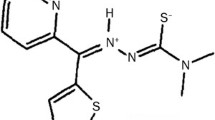Summary
A clone of human gastric cancer cells (AGS-6) and the parental line (AGS-P) from which it was isolated were used in cell survival studies to determine whether pretreatment for 24, 48 or 72h with α-difluoromethylornithine (DFMO, 5mM) would increase the cell's sensitivity to 5-Fluorouracil (5FU), Adriamycin (Adria), 1-(2-chloroethyl)-3-(4-methyl cyclohexyl)-1-nitrosourea (MeCCNU), or Bleomycin (Bleo). Generally, the AGS parental cells were most sensitive to the anticancer agents after exposures to DFMO. However, there was no way to predict in advance from DFMO-induced changes in ornithine decarboxylase (ODC), polyamine or cell kinetics values, how long an exposure to DFMO was required before sensitization to an anticancer agent occurred. The degree of potentiation for a single drug was variable from time to time during exposure to DFMO, and broad differences in the sensitizations were demonstrated among the four anticancer drugs. The AGS-6 clone exhibited little or no increased sensitivity as a result of pretreatment with DFMO, even though the DFMO-induced reductions in ODC and polyamine values in these cells were similar to those produced in the more sensitive parental line.
Similar content being viewed by others
References
Barranco SC, Ford PJ, Townsend Jr CM: Cell cycle kinetics responses of human stomach cancer cells to reduction in polyamine levels by treatment with αDifluoromethylornithine in vitro. Invest New Drugs 4: 347–357, 1986
Barranco SC, Ford PJ, Townsend Jr CM: Heterogeneous survival responses of human gastric cancer clones to αDifluoromethylornithine in vitro. Invest New Drugs 4: 337–345, 1986
Barranco SC, Townsend Jr CM, Quraishi MA, Burger NL, Nevill HC, Howell KH, Boerwinkle WR: Heterogeneous responses of an in vitro model of human stomach cancer to anticancer drugs. Invest New Drugs 1: 117–127, 1983
Cavanaugh Jr PF, Pavelic ZP, Porter CW: Enhancement of 1,3-Bis(2-chloroethyl)-1-nitrosourea-induced cytotoxicity and DNA damage by α-Difluoromethylornithine in L1210 leukemia cells. Cancer Res 44: 3856–3861, 1984
Seidenfeld J, Komar KA: Chemosensitization of cultured human carcinoma cells to l,3-Bis(2-chloroethyl)-1-nitrosourea by difluoromethylorinithine-induced polyamine depletion. Cancer Res 45: 2132–2138, 1985
Gerner EW, Stickney DG, Herman TS, Fuller DJM: Polyamines and polyamine biosynthesis in cells exposed to hyperthermia. Radiation Res 93: 340–352, 1983
Russell D, Snyder SH: Amine synthesis in rapidly growing tissues: ornithine decarboxylase activity in regenerating rat liver, chick embryo, and various tumors. Proc Nat Acad Sci USA 60: 1420–1427, 1968
Guseman LF, Bryant J: Mathematic modeling and analysis of flow microfluorometry DNA distributions. In: D Lutz (ed) Pulse Cytophotometry, Eur Press, Ghent, Belgium, pp 79–92, 1978
Saydjari R, Townsend Jr CM, Barranco SC, James E, Thompson JC: Effects of Cyclosporin A and α-Difluoromethylornithine on the growth of hamster pancreatic cancer in vitro. JNCI 77: 1087–1092, 1986
Sunkara PS, Fowler SK, Nishioka K: Selective killing of transformed cells in combination with inhibitors of polyamine biosynthesis and S-phase specific drugs. Cell Bio Intl Rep 5: 991–997, 1981
Seidenfeld J, Komar KA, Naujokas MF, Block AL: Reduced cytocidal efficacy for adriamycin in cultured human carcinoma cells depleted of polyamines by difluoromethylornithine treatment. Cancer Res 46: 1155–1159, 1986
Bartholeyns J, Koch-Weser J: Effects of α-Difluoromethyl-ornithine alone and combined with adriamycin or vindesine on L1210 leukemia in mice, EMT6 solid tumors in mice, and solid tumors induced by injection of hepatoma tissue culture cells in rats. Cancer Res 41: 5158–5161, 1981
Gerlach JH, Kartner N, Bell DR, Ling V: Multidrug resistance. Cancer Surveys 5: 25–46, 1986
Hamilton TC, Winker MA, Louie KG, Batist G, Behrens BC, Tsuruo T, Grotzinger KR, McKoy WM, Young RC, Ozols RF: Augmentation of adriamycin, melphalan, and cisplatin cytotoxicity in drug-resistant and -sensitive human ovarian carcinoma cell lines by buthionine sulfoximine mediated glutathione depletion. Biochem Pharmacology 34: 2583–2586, 1985
Author information
Authors and Affiliations
Rights and permissions
About this article
Cite this article
Barranco, S.C., Townsend, C.M., Ho, B.Y. et al. Schedule dependent potentiation of antitumor drug effects by α-difluoromethylornithine in human gastric carcinoma cells in vitro . Invest New Drugs 8 (Suppl 1), S9–S18 (1990). https://doi.org/10.1007/BF00171979
Issue Date:
DOI: https://doi.org/10.1007/BF00171979




